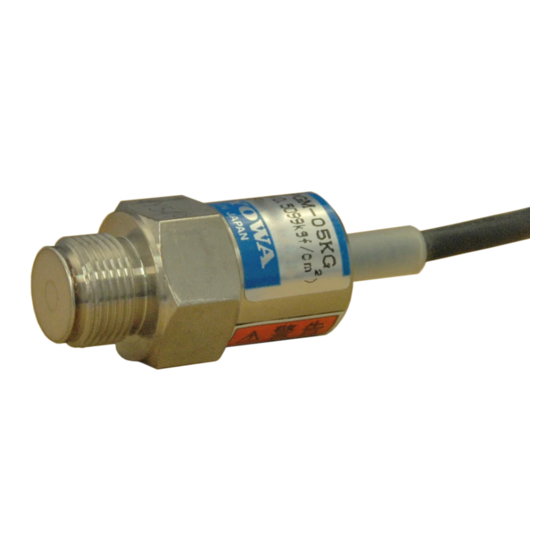
Advertisement
Quick Links
PGM -G Low Pressu re Tran sd u cers INSTR UCTION M ANUAL
Thank you for purchasing the KYOWA product. Before using it, read this
instruction manual carefully. Also, keep the manual within easy reach so that
you can refer to whenever necessary.
Specifications and dimensions described in this manual could be changed
without notice. Please visit our website for the latest version.
1. Callin g th e o p erato r' s atten tion
The following cautionary symbols and headlines are used to invite the
operator' s attention. Be sure to observe the accompanying precautions in
order to safeguard the operator and preserve the performance of the
instrument.
Improper handling can cause serious injury to the
W arn in g
operator
Improper handling can cause deleterious effects to
Cau tio n
the operator' s body
Cautions are given to invite the operator' s attention,
Cau tio n
in order to avoid instrument failure or mal- function.
2. Im p o rtant n otice
Unless specified, the transducer must not be used under hydrogen
environment.
3. Safety p recau tio n s
Avoid pressure in excess of the allowable overload rating, or the
transducer may explode.
Avoid contact of a projecting object with the sensing surface, or the
latter may crack to result in the transducer' s explosion.
Use the specified tightening torque. Improper tightening torque may
cause the transducer' s explosion.
If excessive pressure could possibly occur, provide protective casing
around the transducer installation, in order to safeguard the operator.
Select sufficiently strong material for mounting screw hole.
Dismount the transducer only after the applied pressure has been
completely removed.
SUS304 is used where the transducer contacts a liquid. Avoid
application of the instrument to a corrosive liquid or gas.
4. Han d lin g precau tio n s
Do not disassemble the transducer.
Take care to keep the liquid- contacting part and mount screw from
damages.
Keep the body from external forces.
Do not use the transducer in the vacuum environment.
The bridge excitation voltage should be below 3V.
Protection code is IP54. It should not be used underwater.
No condensing. If it formed condensation, immediately dry.
The diaphragm where the transducer contacts a liquid is very thin. It
may crack contacting a projecting object. Also, it may be damaged
pressed by a finger tip or the like because of overload.
W arn in g
Cau tio n
Cau tion
The cable incorporates a conduit pipe for back- pressure
compensation. Do not cut the cable or the connector plug and
reconstruction. Also, the cable cannot be extended. In addition, please
install the connector plug into the atmosphere.
Do not bend the cable at its outlet. If a cable is bent forcibly, it not only
becomes disconnection, but a tube will be closed and it cannot
perform exact measurement.
Make sure that the bending radius of cable is longer than 10 times of a
diameter of the cable.
In vibration environment, fix the cable at its outlet and required
portions.
Mount the transducer possibly closest to the pressure source.
If the rising time of the dynamic phenomenon to be measured is short,
the total response including the transducer and measuring instrument in
use may be problem.
Before m
easurement, check their specifications.
5. In stallatio n
5.1 Using a new O- ring (accessory), mount the transducer.
・ Tightening torque is 4.9 N- m.
5.2 When conduit is used, install a cock or valve between the conduit and
connection portion to easily mount and demount the wire conduit.
IM-T-123K J ul 2022
Advertisement

Subscribe to Our Youtube Channel
Summary of Contents for KYOWA PGM-G
- Page 1 IM-T-123K J ul 2022 PGM -G Low Pressu re Tran sd u cers INSTR UCTION M ANUAL Thank you for purchasing the KYOWA product. Before using it, read this The cable incorporates a conduit pipe for back- pressure instruction manual carefully. Also, keep the manual within easy reach so that compensation.
- Page 2 Cau tio n 6.1 Connect the transducer to a measuring instrument. To measure insulation resistance, apply a voltage lower than 50V to 6.2 When using a measuring instrument other than KYOWA, connector the insulation resistance tester. plug as follows. 9. Specification s...
- Page 3 IM-T-123K 2022.7 P G M-G 型 低容量圧力変換器-取扱説明書 こ のた びは本製品を お買い上げいた だき ま し て ,あ り がと う ご ケ ーブルの中にはチュ ーブ ( 背圧補償用連通管 ) が内蔵さ れ ざ いま す。ご 使用の前には,本書を 必ずお読みく ださ い。ま た , て いま す。 ケ ーブルやコ ネ ク タ プラ グ の切断, 改造を し な お読みに...
- Page 4 抵抗, 回路( コ ネ ク タ プラ グ のピ ン A ~D のいずれか ) と 本 体間の絶縁抵抗( 100M Ω以上) を 測定し て く ださ い。 異常 があ れば本器の故障と 考え ら れま す。 弊社営業ま でご 連絡 く ださ い。 ホ ーム ページ ア ド レ ス www.kyowa-ei.com...














Need help?
Do you have a question about the PGM-G and is the answer not in the manual?
Questions and answers